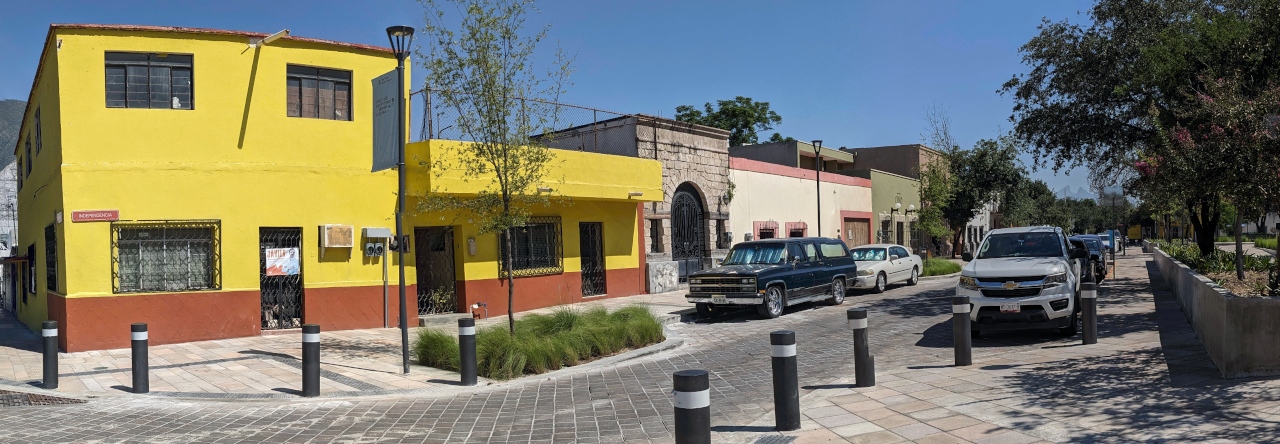Tios Lauro and Tio Lynn and his family spent Christmas Eve with Lorena, Conchita, Christian, and I. Lauro and Lynn, did all the grilling while the rest of us sat around and talked. Christian downloaded some music he wanted to learn and it was just nice to watch him start to work through that. This was as nice a Christmas Eve as I have had for years. The only thing missing was Kelly, but she will be here later today.
I have added a retirement clock to the sidebar of the blog. I am not sure things are going to actually play out in the way the retirement clock is planned, but God willing I hope to be moving from a full time direct employment position to a half-time contract position on or about May 2, 2012–28 months from now. Here is the clock:
Hopefully, this will allow me to spend half of my time working on my PhD, but who knows. More on all this as we go along.
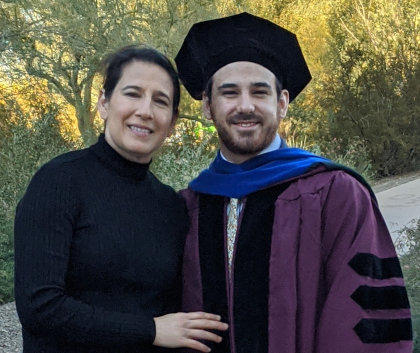
Lorena and I flew to Tempe last week for Christian’s PhD graduation ceremony. It was nothing short of amazing. Several thousan graduated even though the ceremony we attended was just for the schools of engineering. There were bagpipes and speeches and lots of happy people–us included.
Since this is end of Christian’s educational journey, at least for the time being, I thought I would just put down a brief synopsis of his trajectory for posterity.
Age 13 – Homeschool
- Duke University TIP (Talent Identification Program) medal
- Passed first CLEP (college credit exam) test
Age 14 – Wake Technical Community College
- Dean’s list all semesters for two years at
Age 18 – North Carolina State University
- BS in Applied Mathematics
- Dean’s list all semesters
- Honors Mathematics
- Graduated Summa Cum Laude (highest honors)
Age 23 – Arizona State University
- PhD in Electrical Engineering
- Fellow of the Fulton School of Engineering
- MIT funded his fellowship that paid for school and a living stipend
- Published 3 referred journal articles
Age 24 – Boston area
- Accepted a position as a full-time researcher at MIT Lincoln Laboratory

I kept track on my Bible reading on this blog from 2006 through just a few months ago. I decided I would move that record to another place (Google Docs) for a number of reasons, but a lot of it had to do with finding a way to keep better track and read more. Keeping track has been a huge help in terms of keeping me on track (if you will). The main reason I am made the change is to calculate statistics–that is mostly because I just like to do that–and to up my game a little more. The longer I have kept track the more time I have spent in my Bible. Now I am up to reading at a rate where I make it through the whole Bible with two additional passes through the New Testament each year. Next year, I am going to try to do that plus leave myself some room to do a little more in depth study at the end of the year.
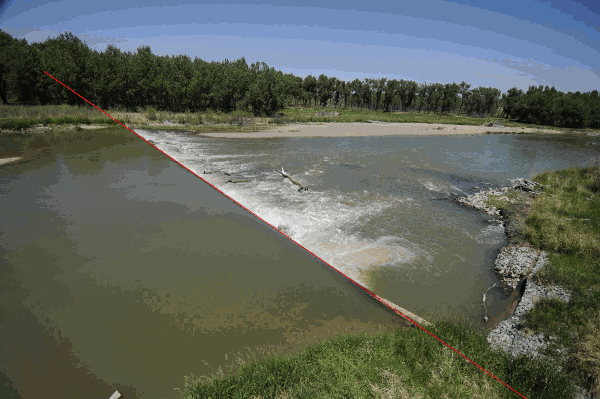
Previous: #5 Features for Images in a Folder
Next: Not yet available
This is the sixth in a series of videos I am creating of the research I am performing under the direction of University of Nebraska Lincoln Professor Troy Gilmore to determine whether we can use images taken at the weir on North Platte River at the Nebraska-Wyoming State Line to replicate measurements of discharge and stage by extracting features from the images and using measurements from USGS sensors as ground truth.
This is the first pass of the weir finder. Notice that it starts missing at night and that it is pretty good, but not perfect. We will refine this.
Previous : #4 Features for Images in a Folder
Next: #6: Finding the Weir
This is the fifth in a series of videos I am creating of the research I am performing under the direction of University of Nebraska Lincoln Professor Troy Gilmore to determine whether we can use images taken at the weir on North Platte River at the Nebraska-Wyoming State Line to replicate measurements of discharge and stage by extracting features from the images and using measurements from USGS sensors as ground truth.
It is necessary to search images with odd (non-rectangular) regions of interest. Eventually, we want to be able to set those regions of interest automatically without manual intervention, but they will help greatly in algorithm development to get started.
Previous: #3 Add a Features Dialog Box
Next: #5 Odd shaped regions of interest
This is the fourth in a series of videos I am creating of the research I am performing under the direction of University of Nebraska Lincoln Professor Troy Gilmore to determine whether we can use images taken at the weir on North Platte River at the Nebraska-Wyoming State Line to replicate measurements of discharge and stage by extracting features from the images and using measurements from USGS sensors as ground truth.
Troy had me add the ability to calculate all the image features for a folder and show them in the GUI. This was a relatively minor change, but it works well. It should be noted that only rudimentary image features are being calculated at this point. We will add more, probably many more, features as we start building classifiers.
Previous: #2 Extracting Metadata from Images
Next: #4 Features for Images in a Folder
This is the third in a series of videos I am creating of the research I am performing under the direction of University of Nebraska Lincoln Professor Troy Gilmore to determine whether we can use images taken at the weir on North Platte River at the Nebraska-Wyoming State Line to replicate measurements of discharge and stage by extracting features from the images and using measurements from USGS sensors as ground truth.
Now that we can look at images, Troy wants a way to start adding features that are calculated from the images. This video is my first pass at adding the functionality we need. It is a dialog box that allows the user to see calculated features for a single image or from a folder of features. It presents the features for a folder of images in comma separated value (CSV) format. That will be used sometime in the future to feed the early machine learning.
Previous: #1 Infrastructure
Next: #3 Add a Features Dialog Box
This is the second in a series of videos I am creating of the research I am performing under the direction of University of Nebraska Lincoln Professor Troy Gilmore to determine whether we can use images taken at the weir on North Platte River at the Nebraska-Wyoming State Line to replicate measurements of discharge and stage by extracting features from the images and using measurements from USGS sensors as ground truth.
Troy’s second task for me was to extract the timestamps and other data from each of the image’s EXIF metadata. That task is now complete and is shown here as an addition to the WaterEval machine learning program for which we laid some groundwork shown in the previous video. We will use this timestamps to select the stage and discharge data from the USGS that applies to each of the images. In addition, we will see whether knowledge of the camera settings changes and can also be added as a feature for our machine learning model.
Next: #2 Extracting Metadata from Images
This is the second in a series of videos I am creating of the research I am performing under the direction of University of Nebraska Lincoln Professor Troy Gilmore to determine whether we can use images taken at the weir on North Platte River at the Nebraska-Wyoming State Line to replicate measurements of discharge and stage by extracting features from the images and using measurements from USGS sensors as ground truth.
My not yet official PhD adviser at University of Nebraska Lincoln is Troy Gilmore. We have been talking via video chat and trading lots of emails in anticipation of getting started after the first of the year. To get a jump on it before I start, Troy has provided me with images of a weir on North Platte River at the Nebraska-Wyoming State Line. He directed me to get started on the infrastructure needed to calculate features from the images that are well suited for use to build a classifier using a Machine Learning model. The first thing he believes we need is a tool to view the images, zoom in and out, load and save images and results, etc. This is the first pass at that. I am sure this application will evolve greatly by the time we are done, but this is our starting place.

Lorena and I enjoyed a quiet evening at home with Kiwi the surviving cat sister on our 27th wedding anniversary. We plan to do something a little more elaborate over the weekend, but it was actually very, very nice just to be together quietly. Lorena made Kung Pao chicken, one of my favorites and we talked about life, were we have been and where we are going.

My desk cycling was going well enough for me that I decided to talk my friend, Stan, into joining me in my efforts to maintain my weight. To that end, I upgraded my DeskCycle to a DeskCycle 2. I think it has pretty much the same hardware as the old cycle, but a little better display and more accurate measurement of calories expended. I like it a lot. I am going to give the original cycle to Stan and we are going to start tracking weight together. Lorena and I have an anniversary today and Stan is taking the Extra Class Amateur Radio license test this week, so we are going to start our joint efforts on Monday.
The GIF above demonstrates that I move around quite a bit when I am riding, but surprisingly, I can actually get quite a lot of work done when I am riding. I am doing about a couple of hours per day of light peddling and it certainly does seem to help although eating right seems to help a lot more.

The mountain was beautiful this morning. The layer of crowds below the mountain covers the town and stops just below the top of the ridge where we live. We are kind of amazed that we are still getting new looks/appearances at the same scene after two and a half years of closely watching. We get this kind of scene of the mountain, foothills, and valley every morning when the clouds do not occlude the view. I need to remember to stop working long enough to look out the window at the right time. Maybe I will put a reminder in my calendar to message me.

We got up at 3:30 this morning and Lorena dropped me off at PDX to catch the 7 AM flight to Boston. Just another day in the commuter life. I found the JetBlue routes to Boston only run for five months per year so next month I will probably have to fly from Seattle which is generally way more hassle in terms of traffic. This trip, I am actually doing my first academic classwork for my PhD. Troy recommended I start with a book titled “Introduction to Open Channel Flow” by Glenn E. Moglen. I am just a few pages in, but it looks tractable but a little bit dry (no pun intended). I am going to see if I can work through the problems at the end of the chapter to keep a record of what I am doing.

A couple of pictures of our place at the time of my 64th birthday. I had a great birthday. Lorena and I went out with our friends, Bob, Gena, Stan, and Diane and our ministers, Gary and James for an absolutely stellar steak. It feels really good to be this age. It took me way longer than it should have to figure out that you need to enjoy the age you are because there is no other option other than to not enjoy it.

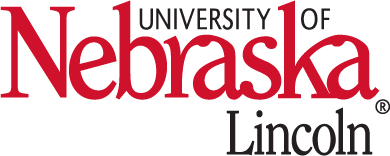
I have written for quite awhile, but I think it is time to break the hiatus. Nothing much has changed other than that things have incrementally moved forward. I have finished my application to the University of Nebraska Lincoln for a PhD in Natural Resources. My work will predominantly be dealing with the remote sensing of water scenes with cameras to make hydrological measurements. I have actually started evaluating data and building infrastructure to due systematic analysis of a particular set of images at a highly visible site that I hope to be able to talk about more fully very soon.
In addition, I have just purchase my first textbook to get started on the study of hydrology. The name of the book is Fundamentals of Open Channel Flow. The reality is that I am absolutely clueless about this topic and am very much looking forward to figuring out what it is all about. I look forward to posting more about the pain of learning this material because it certainly looks fairly obtuse and obscure!

For a lot of reasons, some valid, some not, the painting of the house has taken a lot more time than expected. We are getting close to the end now. We love the colors and it looks beautiful from a distance. That being said, we ran into another hiccup. The area below the porch looks beautiful, but the paint has bubbled in a way that looks like it is due to moisture. It is probably going to take significant rework. We feel bad for our painter, but really need it to be right. We are glad he is such a good guy and stands by his work.
I have not written for quite awhile, mostly because I did not have much that was interesting to say. Hopefully, that has changed although I think my topic is going to be only interesting to a small select group of people. That topic is the starting of a PhD that will almost certainly not be completed until after I retire in the next 4-5 years. I will list a few of the topics I hope to cover in this first post:
- My educational trajectory and how much or little of that applies to the PhD
- My career trajectory and how much or little that applies to the PhD
- How I got started on volunteer work that opened the PhD opportunity
- What I needed to do to get accepted into the PhD program
- My specific PhD program
- What I want to do with the PhD after I get it
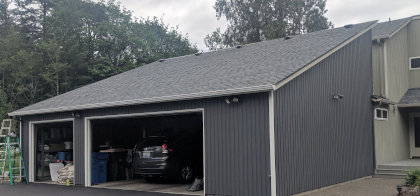 There was a little more progress on the house painting today. They have now painted the main walls and the trim for three sides of the garage so we are starting to get a little bit of a sense for what the whole thing will look like and we like it a lot. The one thing that is totally apparent to us now is that the garage doors absolutely have to go. We are in the process of figuring out what to do about that next.
There was a little more progress on the house painting today. They have now painted the main walls and the trim for three sides of the garage so we are starting to get a little bit of a sense for what the whole thing will look like and we like it a lot. The one thing that is totally apparent to us now is that the garage doors absolutely have to go. We are in the process of figuring out what to do about that next.
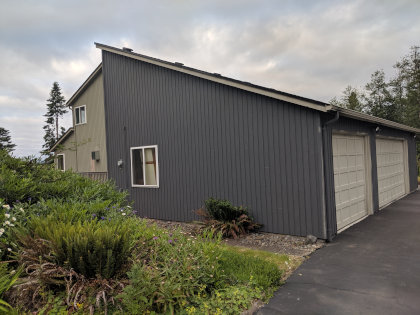 The painting of the house is finally under way. Our painter, Duane, is both an excellent painter and a good friend. His son Gavin is helping him before he starts a new job for the State of Washington. We enjoy eating lunch and talking about life with them on the days they work here. They wedged us in among other work they are doing in the area so it will not all be finished until toward the end of the month. We can hardly wait.
The painting of the house is finally under way. Our painter, Duane, is both an excellent painter and a good friend. His son Gavin is helping him before he starts a new job for the State of Washington. We enjoy eating lunch and talking about life with them on the days they work here. They wedged us in among other work they are doing in the area so it will not all be finished until toward the end of the month. We can hardly wait.
